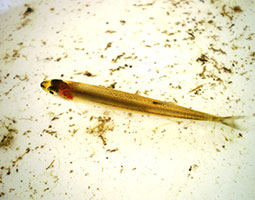Retropinna semoni
Description

Australian Smelt (Retropinna semoni) are a small, elongate, slender, silver fish usually from 40 -100 mm in length. However most populations average 50mm in total length. Australian Smelt are semi-transparent, with purple-olive on the back, a silver-orange streak along the sides and colourless fins. This fish has large eyes, a forked caudal fin and the male can be distinguished from the female by its larger pelvic and pectoral fins.
This freshwater species of pelagic fish prefers slow moving or still water in a variety of habitats including wetlands, billabongs, dams and lakes and can tolerate a variety of salinity levels. They are a schooling fish and can be found in large numbers. In Queensland they adopt a slightly different habit, and can commonly be found in riffles and adjacent shorelines fringed with vegetation or woody debris. Australian smelt adults and juveniles have been found migrating upstream during the day in some river systems with the greatest migration occurring in the afternoon.
Male and female smelt reach sexual maturity after one year but will only live for up to 2 years. Females will lay up to 1000 eggs and will begin spawning when the water temperatures reach in excess of 11–15°C. Smelt are capable of spawning multiple times during the breeding season with females producing batches of eggs every 3–4 days. Australian smelt produce spherical, transparent eggs which are approximately 0.8 - 1 mm in diameter which fall to the bottom and stick to aquatic sediment, plants and debris. Smelt larvae hatch after about 10 days and are 4.5 - 5mm in length.
Australian smelt are only found in Australia, and are distributed widely in coastal drainages from the south east of South Australia along the coast to the Fitzroy River in Queensland. It also occurs widely inland from the Murray River and its tributaries and up the Darling as far upstream as Wilcannia. There are also isolated populations in south-western Queensland and north-western New South Wales.
Adaptations
- Form large schools to reduce effects of predation
- Can inhabit a variety of still waters with a range of salinities
- Can spawn multiple times when conditions are suitable and produces large batches of eggs
Feeding relationships
- What I eat: Aquatic and terrestrial insects, small crustaceans, variety of planktonic organisms
- What eats me: Carnivorous fish (e.g. gudgeons), birds (e.g. Sacred Kingfisher), Large predatory insects (e.g. water scorpion, toad bug)
Interesting facts
Australian smelt apparently produce a cucumber-like odour when freshly caught. They are also an effective predator of mosquitos in ponds within their range, especially in ponds inhabited by frogs.